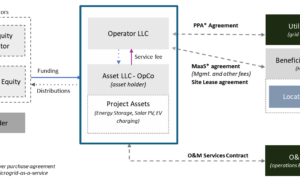Introduction to Energy Transition and its Importance
Energy transition is the movement towards more sustainable and renewable energy system. It involves shifting away from traditional fossil fuels such as coal, oil, and natural gas, towards cleaner sources of energy like solar, wind, hydro, geothermal and biomass. This transition has become increasingly important in recent years due to the growing concerns over climate change and the detrimental effects of carbon emissions on our planet.
The burning of fossil fuels for energy production is one of the main contributors to greenhouse gas emissions, which are responsible for trapping heat in the Earth’s atmosphere and causing global warming. The use of these non-renewable resources also leads to air pollution, water contamination and other environmental hazards that have severe consequences for human health and well-being.
Therefore, there is a pressing need for countries around the world to shift towards more sustainable forms of energy production. This not only helps mitigate the negative impacts of climate change but also creates new economic opportunities by reducing dependence on expensive imported fuels.
Importance of Energy Transition
There are several reasons why energy transition is crucial in today’s world but to mitigate Climate Change is the most significant. By reducing carbon emissions from fossil fuel consumption, we can limit global warming and its associated catastrophic effects such as extreme weather events, rising sea levels, loss of biodiversity and displacement of communities.
Understanding Local Initiatives for Energy Transition
Local initiatives for energy transition refer to the various projects and programs implemented at a community level with the aim of transitioning towards more sustainable and renewable sources of energy. These initiatives are led by individuals, organizations, and communities who recognize the importance of reducing reliance on fossil fuels and mitigating the negative impacts of climate change.
One key aspect of understanding local initiatives for energy transition is recognizing that they are driven by a strong sense of community engagement and empowerment. Unlike large-scale government or corporate-led projects, these initiatives involve active participation from community members, allowing them to take ownership of their energy future.
Another important factor in understanding local initiatives for energy transition is their focus on finding solutions that are tailored to the specific needs and resources of a particular community. This approach recognizes that each community has its unique geographical, social, economic, and environmental characteristics that must be considered when developing sustainable energy solutions.
One common type of local initiative for energy transition is the establishment of community-owned renewable energy projects. These projects involve local citizens coming together to develop and operate renewable energy systems such as solar panels or wind turbines. These projects not only provide clean and affordable energy but also create new job opportunities within the community.
In addition to producing clean energy, these initiatives also promote education and awareness about sustainable living practices. For example, some communities have started educational programs focused on teaching children about renewable energy technologies and their benefits for the environment.
Case Studies of Successful Community-driven Energy Projects
Community-driven energy projects have been gaining traction in recent years as a way to empower local communities and promote sustainable energy practices. These initiatives are often spearheaded by grassroots organizations, non-profits, or local governments, and involve the active participation of community members.
- Solar Gardens in Colorado
One notable example of a successful community-driven energy project is the Solar Gardens program in Colorado. This initiative allows residents who are unable to install solar panels on their own properties to purchase shares in a larger solar array located elsewhere in their community. The electricity generated from these shared arrays is then credited back to the participants’ utility bills.
The program has been incredibly successful, with over 8,000 households participating and generating enough clean energy to power over 100,000 homes. This not only reduces carbon emissions but also provides cost savings for participants and promotes renewable energy adoption within the community.
- Wind Farms in Denmark
Denmark has long been a leader in sustainable energy practices and has achieved remarkable success with its community-owned wind farms. These projects are owned and operated by local co-operatives consisting of farmers, landowners, and other community members.
By involving the local community in the decision-making process and sharing profits from wind farm operations with them, these projects have gained widespread support and acceptance within Danish society.
Impact of Local Initiatives on Environment and Economy
Local initiatives have a crucial role to play in promoting sustainable development and achieving a smooth transition towards renewable energy sources. These initiatives, led by community members and organizations, focus on addressing environmental concerns while also generating economic benefits for the local economy.
One of the major impacts of local initiatives on the environment is reducing carbon emissions. By promoting the use of clean and renewable energy sources such as solar power, wind power, and geothermal energy, these initiatives help to decrease our reliance on fossil fuels. This not only reduces air pollution but also helps to combat climate change by decreasing greenhouse gas emissions.
Moreover, many local initiatives also prioritize waste management and encourage recycling programs within their communities. This helps to reduce the amount of waste sent to landfills and promotes a circular economy where resources are reused. In addition, some communities have implemented composting programs that turn organic waste into nutrient-rich soil for gardens or farms, reducing the need for chemical fertilizers.
These efforts towards sustainable practices not only benefit the environment but also have positive effects on the local economy. For instance, investing in renewable energy infrastructure creates job opportunities in installation and maintenance services. Additionally, supporting local businesses that provide eco-friendly products or services boosts the growth of green industries within the community.
Furthermore, many local initiatives focus on educating community members about sustainability and how they can incorporate it into their daily lives. This awareness not only leads to more environmentally conscious behaviors but can also lead to cost savings for individuals through energy efficiency practices
Challenges Faced by Communities in Implementing Energy Transition
Energy transition refers to the shift from traditional, fossil fuel-based energy sources to renewable and sustainable alternatives. This global movement is driven by the urgent need to mitigate the impacts of climate change and reduce our dependence on finite resources. However, implementing energy transition at a community level is not without its challenges
- Financial Constraints
One of the major challenges faced by communities in implementing energy transition is financial constraints. Transitioning to renewable energy sources often requires significant upfront investments in infrastructure, such as solar panels or wind turbines. Many communities, particularly those in developing countries or marginalized areas, do not have access to these funds and are unable to finance such projects on their own. Lack of government support or funding can also hinder progress in transitioning towards clean energy.
- Lack of Awareness and Education
Another challenge faced by communities is a lack of awareness and education. They do not know benefits and methods of implementing energy transition. Many people are still unaware of how their everyday actions contribute to climate change and how they can play an active role in reducing carbon emissions through clean energy initiatives. Furthermore, there may be limited knowledge about available technologies and resources for transitioning to renewable energy sources.
- Legal Barriers
Some communities may face legal barriers that prevent them from implementing local initiatives for energy transition. For example, certain regulations or policies may favor traditional fossil fuel-based industries over clean energy alternatives, making it difficult for individuals or groups to get permission to start the initiative.
How Individuals Can Get Involved in Local Energy Initiatives
Individuals play a crucial role in driving energy transition and creating sustainable communities. By getting involved in local energy initiatives, individuals can make a significant impact on reducing carbon emissions, promoting renewable energy, and fostering community resilience. Here are some ways individuals can get involved in local energy initiatives:
- Educate Yourself: The first step towards getting involved in local energy initiatives is to educate yourself about the current state of energy production and consumption in your community. This includes understanding where your electricity comes from, how it is generated, and what sources of energy are available locally.
- Join Community Groups: Many communities have groups or organizations dedicated to promoting clean energy and addressing environmental issues. These groups often organize events, workshops, and campaigns to raise awareness and advocate for sustainable practices. Joining such groups is an excellent way to get involved in local energy initiatives and connect with like-minded individuals.
- Volunteer: Volunteering your time and skills can be a great way to contribute to local energy initiatives. You can volunteer at community events focused on sustainability or offer your expertise in areas like marketing, design, or outreach.
- Support Renewable Energy Projects: If there are any renewable energy projects planned or underway in your community, consider supporting them by investing or purchasing shares if they are publicly owned. This not only helps fund the project but also creates a sense of ownership within the community.
Conclusion
Local communities play a crucial role in driving sustainable change through energy transition initiatives. These grassroots efforts contribute to reducing carbon emissions and mitigating the effects of climate change. They also empower individuals and neighborhoods to take control of their own energy consumption. By working together towards a common goal, members of a community can pool their resources, knowledge, and skills to create meaningful change. This sense of collaboration and collective action not only creates a stronger sense of community but also fosters a deeper understanding of the importance of sustainability.



































